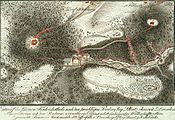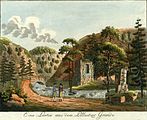Friedrichsgrund
Coordinates: 51 ° 0 ′ 55.5 ″ N , 13 ° 53 ′ 9.1 ″ E
The Friedrichsgrund , also called Meixgrund , is a side valley on the right bank of the Elbe that extends between the Dresden district of Pillnitz and the Meixmühle. The bottom is traversed by the Friedrichsgrundbach , also known as the Meixbach , for about 1.5 kilometers , which created the Kerbtal , which is about 80 meters deep . The name comes from the Elector Friedrich August III. von Sachsen , who had a footpath built here around 1780 with numerous stone bridges and other smaller staffage structures, some of which have been preserved to this day.
history
The Meixgrund was first mentioned in 1403 on a donation document from Margrave Wilhelm von Meißen as "Vallis Michcz" (Meutziggrund or Meitzgrund).
The reason, which can be easily reached from the nearby Pillnitz Castle , was created around 1780 by careful interventions in the existing forest and valley landscape for hikes by Elector Friedrich August III. adapted from Saxony . For this purpose, under the leadership of Count Marcolini, an artificial waterfall, stone benches and bridges as well as other monuments and small buildings were built. For the artificial waterfall, three water basins were built, which were fed by a canal from the Meixmühlenteich and by rain and melt water from the neighboring fields. You could let it go if necessary to enable a 15 to 20 minute waterfall.
Not far from a "grayish hut" at the entrance to the valley and the adjoining waterfall, Marcolini had a scaled-down stone image of the legendary Irminsul (Irmin column), the central sanctuary of the Saxon tribe , built. The original, in the form of a large oak or wooden column, was destroyed by Emperor Charlemagne in 772 during his Saxon campaigns in Westphalia. Buildings with a personal connection to the Elector were also built along the hiking trail, such as B. “Amalia's Rose Hill”, a structural dedication with a column and attached vase for the wife of the Elector, Marie Amalie Auguste .
On a southern hill above the Friedrichsgrund, an artificial ruin in the form of a dilapidated Gothic knight's castle was built in 1785, most likely under the direction of Johann Daniel Schade . Their interior is used u. a. as a dining room for entertaining courtly society, especially at the end of the electoral walks. A similar structure in the form of an artificial grotto known as the “ Hermitage ” was built ten years earlier on the nearby Borsberg . Furthermore, several wooden tents, which were grouped around the Hermitage and of which foundations can still be seen today, belonged to the equipment of the Borsberg. In the 19th century, Friedrichsgrund , now named after the future king , including its continuation through the hiking trail to the Borsberg, developed into a popular excursion destination for both the nature-loving prince-elector and the residents of Pillnitz .
August Bebel visited Friedrichsgrund in 1886 and headed a state delegates' conference in the Meixmühle of the SPD, which was banned by the Socialist Act at the time .
The part of the ground in the village of Pillnitz was fortified in the 19th century; Around 1900 this section was expanded to become a driveway.
Meixmühle
The Meixmühle located at the northeast end of the Friedrichsgrund was first mentioned in a document in 1403. According to the legend, the name goes back to the dragon Meix, who once lived in the Meixgrund and asked a farmer's maid as a sacrifice every year. A miller's boy killed the monster and thus saved the miller's daughter from death.
The mill developed into a popular excursion destination as early as the 19th century. It was completely destroyed in a fire in 1895 and rebuilt the following year. In 1896 the wooden Wendenhof, which had previously been presented at the Saxon arts and crafts exhibition, was moved next to the inn. It still forms the access gate from Friedrichsgrund to the Meixmühle guest garden. In 1903 the dragon castle was built, which is supposed to remind of the legend of the dragon Meix.
In 1931 the Meixmühle became a hostel and from 1945 it served as a children's holiday camp. After extensive renovation, the restaurant reopened in 1992.
Historical illustrations
The waterfall in Friedrichsgrund ( J. P. Veith , approx. 1795)
In Friedrichsgrund near Pillnitz ( J. F. Wizani , approx. 1800)
See also
- Pillnitz Castle - summer residence of the Saxon electors and kings
- List of cultural monuments in Pillnitz
literature
- Hans-Günther Hartmann: Pillnitz - castle, park and village . Hermann Böhlaus successor. Weimar 1996, ISBN 978-3-74000-995-3 .
- Kirsten Krepelin and Thomas Thränert: The dedicated landscape - walks and beautified landscapes around Dresden , Wernersche Verlagsgesellschaft, Worms 2011, pp. 109–130.
- Stefanie Melzer: At 6 o'clock in the morning, his electorate went to the Hermitage ... To design Friedrichsgrund and Borsberg slopes in the style of the early sentimental landscape garden . In: Yearbook of the State Palaces, Castles and Gardens of Saxony 2006, pp. 173-184, ISBN 978-3-937602-97-4 .
Web links
Individual evidence
- ↑ a b Donation of the Pillnitz property by Margrave Wilhelm von Meißen to the wife of Heinrich von Karras on August 5, 1403, see Hans-Günther Hartmann: Schloss Pillnitz , Verlag der Kunst Dresden, 1991, ISBN 3-364-00222-3 , P. 16
- ^ A b Hans-Günther Hartmann: Pillnitz - castle, park and village. Hermann Böhlaus successor, 1996, ISBN 978-3-74000-995-3 , pp. 136-138.
- ↑ Stefanie Melzer: At 6 a.m. they went ... , Sandstein Verlag Dresden, 2006, ISBN 978-3-937602-97-4 , p. 178
- ^ Hans-Günther Hartmann: Pillnitz - Castle, Park and Village. Hermann Böhlaus successor, 1996, ISBN 978-3-74000-995-3 , p. 139. See Fritz Löffler: Das Alte Dresden. 16th edition, Leipzig: Seemann, 2006, ISBN 9783865020000 , p. 335.
- ↑ Stefanie Melzer: 17th Elbhangfest: Look at the beautiful gardens Zier - The Pillnitzer Friedrichsgrund. In: Elbhangkurier, edition 5/2007; P. 3.
- ↑ Stefanie Melzer: At 6 a.m. they went ... , Sandstein Verlag Dresden, 2006, ISBN 978-3-937602-97-4 , p. 174
- ↑ Meixgrund . Dresden districts. 2011. Retrieved December 23, 2011.
- ↑ Stefanie Melzer: Early at 6 o'clock went ... , Sandstein Verlag Dresden, 2006, ISBN 978-3-937602-97-4 , p. 182








